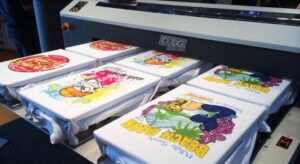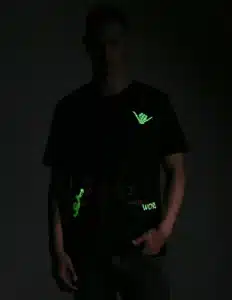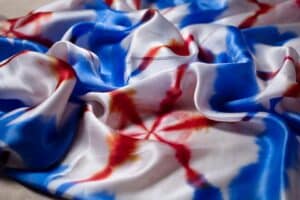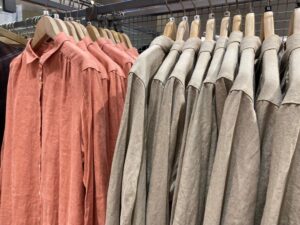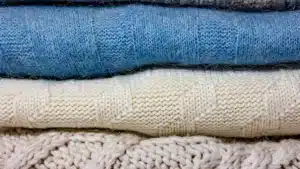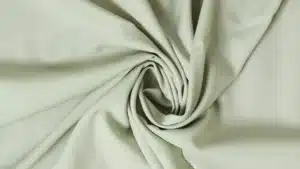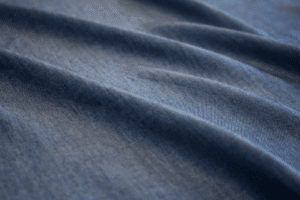Whether you’re branding apparel for your business or creating custom clothing with print logo for a special event, the method you choose can make all the difference. Picking the right one depends on your design, budget, and the type of garment you’re working with.
Key Takeaways
Pick the best printing method for your design and fabric. Choices include screen printing, heat transfer, DTG, dye sublimation, and more.
Screen printing works well for bold designs and large orders. It lasts long and has bright colors but isn’t good for tiny details.
Heat transfer printing is great for detailed, colorful designs. It’s good for small orders and easy to customize.
DTG printing is perfect for small amounts and complex designs. It makes high-quality prints but costs more for big orders.
Dye sublimation works best on polyester fabrics. It creates bright, lasting designs and is eco-friendly, great for sports jerseys.
3D embossed printing gives designs a cool texture. It’s great for fancy brands and needs thicker fabrics.
Reflective printing makes clothes easier to see, good for safety gear and outdoor wear. It’s stylish and useful.
Glow-in-the-dark printing is fun and useful. It’s great for kids’ clothes and event items, adding a special touch.
1. Silk Screen Printing
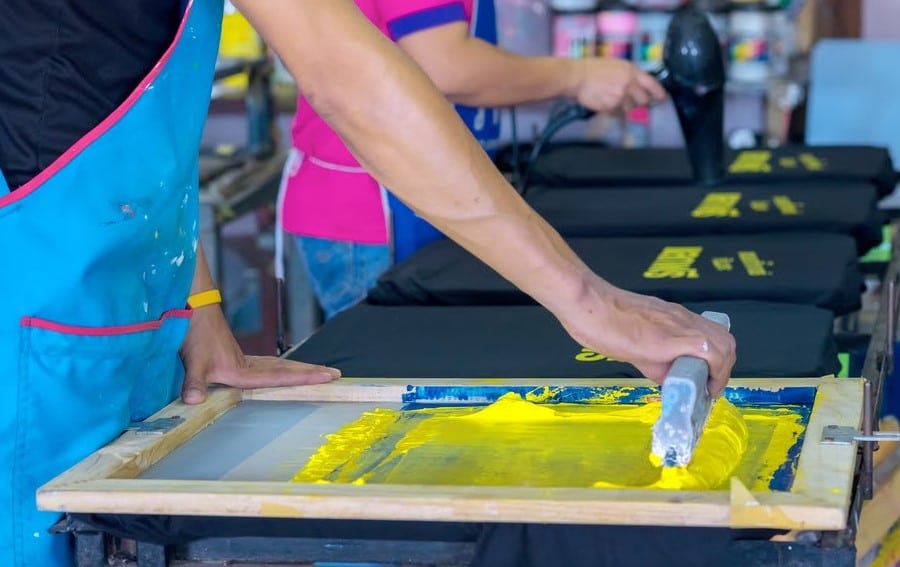
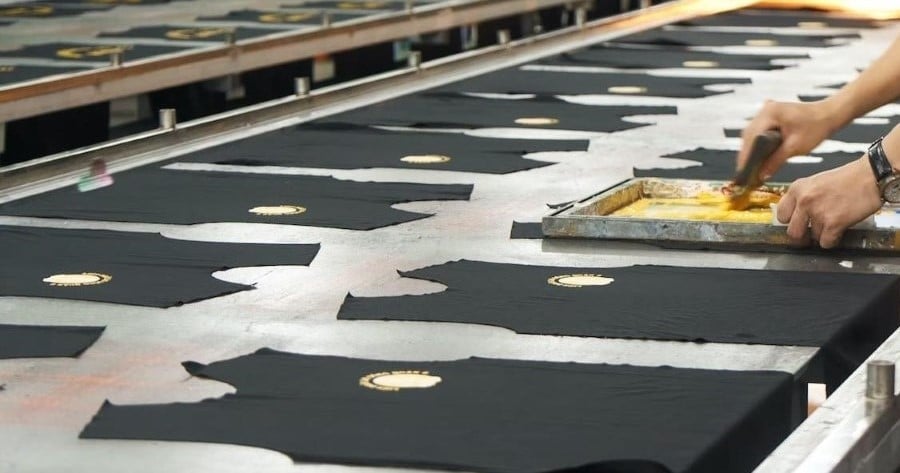
How It Works
Screen printing is a common way to put logos on clothes. You make a stencil (called a screen) of your design, then push ink through it onto the fabric with a tool. Each color needs its own screen, so it’s best for simple, bold designs. The ink sticks well, giving bright, long-lasting results.
This technique works well on a variety of fabrics.
Cotton: Known for its durability and excellent color absorption.
Polyester: A durable choice that suits many printing needs.
Blended fabrics: These combine comfort and print quality.
If you're working with eco-friendly materials like linen or hemp, silk screen printing can also deliver great results.
Advantages
Why choose silk screen printing? Here are some reasons:
Durability: The ink goes deep into the fabric, so it doesn’t fade after lots of washes.
Vibrant Colors: It makes bold, stand-out prints, perfect for logos.
Cost-Effective for Bulk Orders: Once the screens are created, printing large quantities becomes affordable.
Works on Most Fabrics: It works on various fabrics and can handle different types of designs.
It’s a solid choice if you want bright, tough prints at low cost, especially for bulk orders.
Disadvantages
While silk screen printing has many benefits, it’s not without its drawbacks:
Limited Detail: Fine details or intricate designs may not be presented well with this method.
If your design involves a lot of details, you might want to explore other options like direct-to-garment printing, heat transfer printing or sublimation printing.
Best Use Cases
Screen printing is awesome for:
Bulk Orders
Planning an event? Silk screen printing is cheap and fast for creating matching t-shirts, hoodies, or bags in large quantities.Bold and Simple Logo Designs
If your logo features bold lines, solid colors, or minimal details, screen printing delivers exceptional results. The method’s ability to produce solid and long-lasting prints ensures your design pops on any fabric.Promotional Merchandise
Silk screen printing works great on a variety of products, from t-shirts to canvas bags. It’s a great way to showcase your brand at events. The durability of the prints ensures your logo stays visible, even after repeated use.Custom Apparel for Schools or Clubs
Perfect for uniforms or jerseys that last.
Tip: Use fewer colors to save money and time.
It’s perfect for bold, lasting designs on all kinds of fabrics.
2. Heat Transfer Printing
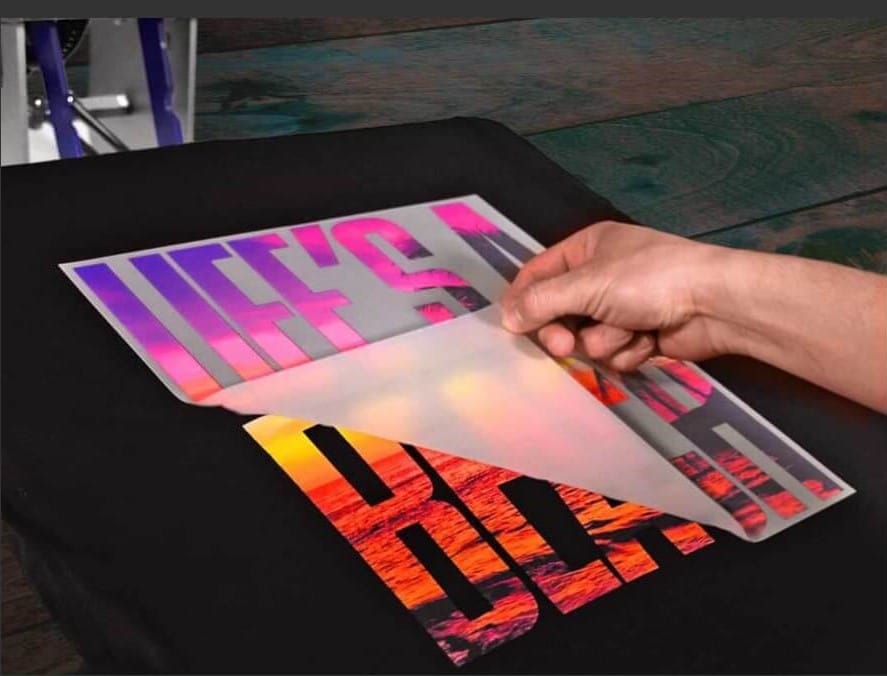
How It Works
Heat transfer printing is an easy way to add logos. You print your design on heat transfer paper or vinyl, then use heat and pressure to stick it onto the fabric with a heat press. It’s good for cotton, polyester, and blends, and it makes bright, full-color designs that pop.
Advantages
A go-to choice for custom logo printing:
Vivid Colors and Details: It makes sharp, detailed designs with lots of colors.
Flexibility: Good for cotton, nylon, or even stretchy stuff.
Low Setup Costs: Unlike screen printing, heat transfer doesn’t require screens or stencils. This makes it ideal for small orders or one-off projects.
Durability: Modern heat transfer methods, like direct-to-film (DTF) transfers, are highly durable. They resist cracking, fading, and peeling, even after multiple washes and drying cycles.
Pro Tip: Use a high-quality heat press machine for the best results. Consistent heat and pressure are key to ensuring your design adheres properly to the fabric.
Disadvantages
While heat transfer printing has many perks, it’s not without its downsides:
Cost For Big Orders: For big orders, this method may not be as cost-effective as screen printing.
Time-Consuming for Big Orders: Each piece needs its own press, slowing things down.
Heat Sensitivity: Some fabrics, like silk or wool, may not withstand the high temperatures required for heat transfer printing.
Despite these drawbacks, heat transfer printing remains a popular choice for small to medium-sized projects, especially when you need vibrant, detailed designs.
Best Use Cases
Here are some of the best scenarios where heat transfer printing truly shines:
Small Orders or Personalized Items
If you’re creating a few custom t-shirts or personalized gifts, heat transfer printing is perfect. You can easily add names, numbers, or unique designs to each item at an affordable cost.Intricate or Full-Color Designs
Got a logo with lots of details or a rainbow of colors? Heat transfer printing handles complex designs like a pro. Unlike screen printing, it doesn’t require separate setups for each color. This makes it ideal for printing photorealistic images, detailed artwork, or multi-color logos.Sports Jerseys and Team Gear
Need to add player names and numbers to uniforms? Heat transfer printing makes it easy to customize each jersey. It’s a popular choice for sports teams because it allows you to create professional-looking gear without the hassle of large production runs.
Did You Know? Heat transfer printing can even be used for non-clothing items like mousepads, coasters, or banners. It’s a versatile method that goes beyond just apparel.
It’s a flexible, fun choice for vibrant designs.
3. Direct-to-Garment (DTG) Printing
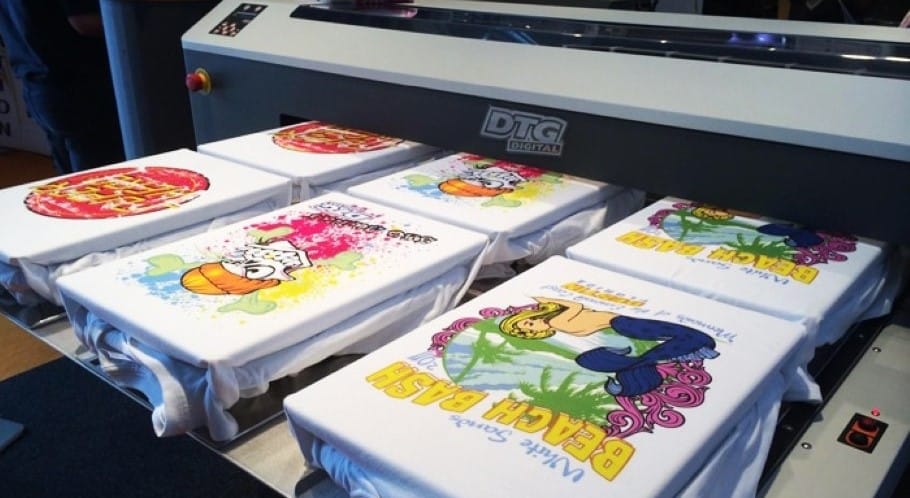
How It Works
Direct-to-garment printing, or DTG, is a modern method that uses advanced digital technology to print designs directly onto fabric. Think of it as a high-tech inkjet printer, but for clothing. The process starts with pre-treating the garment to prepare it for printing. Once prepped, the fabric is loaded into the DTG printer, where DTG inks are applied directly to the fibers. This creates vibrant, detailed designs that feel soft to the touch.
If you’re looking for a fast and efficient way to create custom logo printing with stunning detail, DTG is a great choice.
Advantages
DTG printing offers several benefits that make it a standout option for custom logo printing:
High-Quality Prints: The digital process ensures sharp, detailed designs with vibrant colors. It’s ideal for complex artwork or logos with gradients.
Soft Finish: Unlike screen printing, DTG prints don’t sit on top of the fabric. The ink bonds with the fibers, creating a smooth, soft finish.
Eco-Friendly: Water-based inks are available for DTG, which are less harmful to the environment compared to traditional methods. It also produces less waste and uses less water.
Pro Tip: Always use high-resolution artwork for the best results. Low-quality images can lead to blurry or pixelated prints.
Disadvantages
Fabric Limitations: DTG works best on cotton fabrics. Synthetic materials like polyester may not absorb the ink as effectively, leading to dull prints.
Design Limitations: Certain factors can affect the final output:
Inconsistent pretreatment application.
Low-resolution artwork.
Improper garment loading, which can misalign the design.
Cost for Bulk Orders: DTG is more expensive per unit compared to screen printing, especially for large quantities.
Despite these drawbacks, DTG remains a fantastic option for detailed, high-quality designs. It’s especially useful for small orders.
Best Use Cases
Direct-to-garment printing is a fantastic choice for specific projects where quality and detail matter most.
Small Batch Orders
If you’re working on a small order, DTG printing is your best friend.Complex or Detailed Designs
It’s ideal for photo-realistic images or artwork that other methods might struggle to reproduce.Eco-Friendly Projects
If sustainability is important to you, DTG printing is a solid choice. It can use water-based inks and produces less waste compared to traditional methods. This makes it a greener option for environmentally conscious creators.
Direct-to-garment printing is a versatile and reliable method for creating custom apparel.
4. Dye Sublimation Printing


How It Works
Dye sublimation printing is a fascinating process that turns solid dye into gas without going through a liquid phase. Here’s how it works. First, your design is printed onto special sublimation paper using sublimation ink. Then, the paper is placed on the fabric, and heat and pressure are applied using a heat press. The heat causes the dye to transform into gas, which bonds with the fibers of the fabric. This creates a vibrant, permanent design that becomes part of the material itself.
This method works best on polyester fabrics or items with a polyester coating. It’s not suitable for cotton or natural fibers because they don’t bond with the dye. But for polyester, sublimation printing delivers stunning results.
Pro Tip: Always use white or light-colored fabrics for the best results. Dark fabrics don’t work well with sublimation since the dye doesn’t show up as vividly.
Advantages
Dye sublimation printing offers some amazing benefits that make it a favorite for custom logo printing:
Vibrant and Long-Lasting Colors: The dye becomes part of the fabric, so the colors won’t fade, crack, or peel over time. Your designs will look fresh even after many washes.
Seamless Finish: Since the design is embedded into the fabric, you won’t feel any texture or stiffness. It’s perfect for creating smooth, professional-looking apparel.
Full-Color Designs: Sublimation printing handles complex, multi-color designs with ease. Gradients, photos, and intricate patterns come out beautifully.
Eco-Friendly: Sublimation uses water-based inks and produces minimal waste, making it a greener option compared to some other methods.
Did You Know? Sublimation printing works great for creating all-over designs on t-shirts. You can cover the entire garment with your design for a truly unique look.
Disadvantages
While dye sublimation printing has some advantages, here are some drawbacks to keep in mind:
Fabric Limitations: This method only works on polyester materials.
High Initial Costs: The equipment for sublimation printing can be expensive. It’s a significant investment if you’re just starting out.
Color Restrictions: Sublimation works best on white or light-colored fabrics. Dark fabrics don’t produce the same vibrant results.
Despite these challenges, sublimation printing is a fantastic choice for creating vibrant, durable designs on polyester fabrics.
Best Use Cases
If you’re wondering whether this technique is right for you, here are some of the best scenarios where it truly shines:
All-Over T-Shirt Designs
Dye sublimation is perfect for all-over designs. Since the dye bonds directly with the fabric, you can cover every inch of the garment with your design. Whether it’s a bold pattern, a photo, or a gradient, the results will look seamless and vibrant.Sports Jersey and Activewear
Polyester is the go-to fabric for custom sports jersey, and sublimation printing works beautifully on it. You can create custom jerseys, leggings, or workout gear with sharp, long-lasting designs. Plus, the smooth finish ensures the fabric stays breathable and comfortable during use. Your team or brand will look professional and stylish.Fashion and Streetwear
If you’re in the fashion world, sublimation printing lets you experiment with bold, creative designs. You can print intricate patterns, abstract art, or even full photographs onto garments. It’s a great way to produce unique, high-quality pieces that stand out in a crowd.
Dye sublimation printing is a versatile and reliable choice for vibrant, durable designs. Whether you’re creating custom apparel, promotional items, or sports team uniforms, this method ensures your work stands out and lasts.
5. 3D Embossed Printing
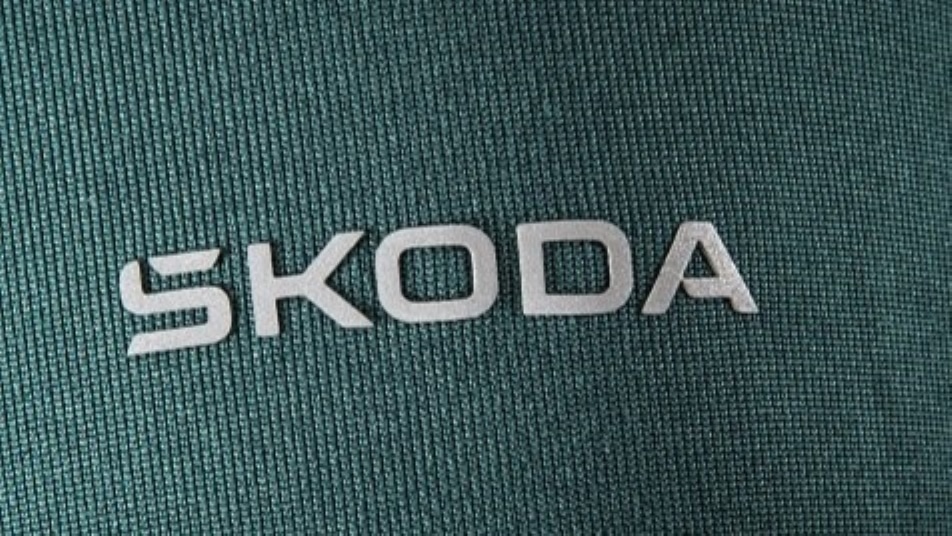
How It Works
3D embossed printing is a unique method that adds depth and texture to your designs. Instead of just printing a logo onto fabric, this technique creates a raised, three-dimensional effect.
Here’s how it works. First, a mold or stencil of your design is created. This mold is then pressed onto the fabric using heat and pressure. The combination of these elements raises the material, forming a textured design that stands out - literally!
This method works best on thicker fabrics like denim, leather, or heavy cotton. If you’re looking to create a tactile, eye-catching logo, 3D embossed printing is worth considering.
Pro Tip: Use bold and simple designs for the best results. Intricate details may not translate well into the raised effect.
Advantages
Here are some of its standout benefits:
Premium Look and Feel: The raised texture adds a luxurious touch to your clothing. It’s perfect for brands that want to convey sophistication and quality.
Unique Aesthetic: The three-dimensional effect makes your logo pop, helping it stand out from flat designs.
Disadvantages
Here are a few drawbacks to keep in mind:
Fall Off: There will be scratches and friction during cleaning. When 3D logos are subjected to force, it will weaken the printing base adhesive and solidity.
Design Restrictions: Complex or highly detailed logos may lose clarity when embossed. Simple, bold designs work best.
Time-Consuming: The process of creating molds and embossing each item takes time. If you’re on a tight deadline, this might not be the best option.
Not Ideal for Colorful Designs: Since embossing focuses on texture rather than color, it’s not suitable for logos that rely on vibrant hues or intricate patterns.
Despite these limitations, 3D embossed printing remains a fantastic choice for creating high-quality, tactile designs.
Best Use Cases
If you’re wondering where 3D embossed printing truly shines, here are some of the best scenarios to consider:
Luxury Branding
3D embossed printing is perfect for high-end products. The raised texture adds a touch of elegance that flat designs just can’t match.Custom Apparel for Fashion Brands
If you’re in the fashion industry, 3D embossed printing can elevate your designs. It works great on denim jackets, hoodies, or even caps. The textured effect adds depth and makes your logo or artwork pop.
Pro Tip: Stick to bold, simple designs for the best results. Intricate details may not translate well into the raised effect.
6. Reflective Printing

How It Works
Reflective printing is a specialized method that enhances visibility by using materials that reflect light. This technique involves applying reflective ink or heat-transfer vinyl onto fabric. When light hits the reflective surface, it bounces back toward the source, making the design highly visible, especially in low-light conditions.
This means your logo will still shine brightly, whether the light comes from directly in front or off to the side. Reflective printing works best on fabrics like polyester and nylon, which are commonly used in outdoor and safety gear.
If you’re creating custom logo printing for workwear or outdoor apparel, reflective printing is a fantastic choice. It not only makes your design stand out but also adds a layer of safety for the wearer.
Advantages
Reflective printing offers several benefits that make it a popular choice for both safety and style:
Enhanced Visibility: The reflective materials ensure your design is visible from far away, even in poor lighting. This makes it ideal for safety gear and outdoor clothing.
Durability: Reflective prints are built to last, ensuring your design stays effective over time.
Wide-Angle Reflectivity: The reflective effect works even when light hits the material at extreme angles, providing consistent visibility.
Safety Compliance: Reflective printing meets important safety standards, making it a reliable choice for workwear.
Reflective printing isn’t just about safety. It’s also a stylish option for outdoor clothing and fashion designs. Whether you’re creating custom logo printing for a brand or a safety project, this method delivers both function and safety.
Disadvantages
While reflective printing has many perks, it’s not without its challenges:
Limited Fabric Options: Reflective materials work best on synthetic fabrics like polyester and nylon. They don’t adhere well to natural fibers like cotton.
Higher Costs: The specialized materials and processes can make reflective printing more expensive than other methods.
Design Restrictions: Reflective printing works best with simple, bold designs. Intricate details may not reflect light as effectively.
Color Limitations: Reflective materials often come in limited colors, mainly in silver color, which might not suit every design.
Maintenance Needs: While durable, reflective prints require proper care to maintain their reflective properties. Avoid harsh detergents or high-heat drying to keep the design intact.
Despite these drawbacks, reflective printing remains a top choice for projects where visibility and safety are priorities. It’s a reliable method for creating designs that stand out - literally.
Best Use Cases
Let’s dive into some of the top scenarios where reflective printing truly stands out.
Safety Gear for Workplaces
Reflective printing is a must-have for industries where visibility is critical. Think construction workers, road crews, or warehouse staff. Adding reflective logos or designs to vests, jackets, or hats ensures workers stay visible in low-light conditions. It’s not just practical—it’s lifesaving. If you’re creating custom workwear, this method helps you meet safety standards while keeping your team looking professional.Outdoor and Sports Apparel
Reflective printing is perfect for activewear. It enhances visibility during early morning jogs or late-night bike rides. You can add reflective strips, logos, or patterns to jackets, leggings, or backpacks. This way, your customers stay safe while enjoying their outdoor adventures.School Uniforms and Kids’ Clothing
Parents love anything that keeps their kids safe. Reflective printing on school uniforms, backpacks, or jackets ensures kids are visible to drivers during early mornings or evenings. It’s a thoughtful addition that combines functionality with peace of mind.Event Merchandise
Hosting a nighttime event like a concert, marathon, or festival? Reflective printing adds a unique touch to your merchandise. T-shirts, caps, or wristbands with reflective designs not only look cool but also help attendees stand out in the crowd.Fashion and Streetwear
Reflective printing isn’t just for safety - it’s a trendsetter in the fashion world. Designers use it to create bold, eye-catching pieces that pop under flash photography or streetlights. Jackets, hoodies, or sneakers with reflective accents give your brand a modern, edgy vibe.
Pro Tip: Pair reflective printing with dark fabrics for a striking contrast. The reflective effect will stand out even more, making your designs impossible to miss.
Cycling and Motorbike Gear
Reflective printing is a game - changer for bikers. Adding reflective logos or patterns to jackets, gloves, or helmets boosts visibility on the road. It’s a stylish way to prioritize safety without compromising on design.Pet Accessories
Don’t forget about our furry friends! Reflective printing on pet collars, leashes, or harnesses keeps pets visible during nighttime walks. It’s a thoughtful touch that pet owners will appreciate.
Reflective printing is versatile, practical, and stylish. Whether you’re designing for safety, fashion, or fun, this method ensures your creations shine in all the right ways.
7. Glow-in-the-Dark Printing
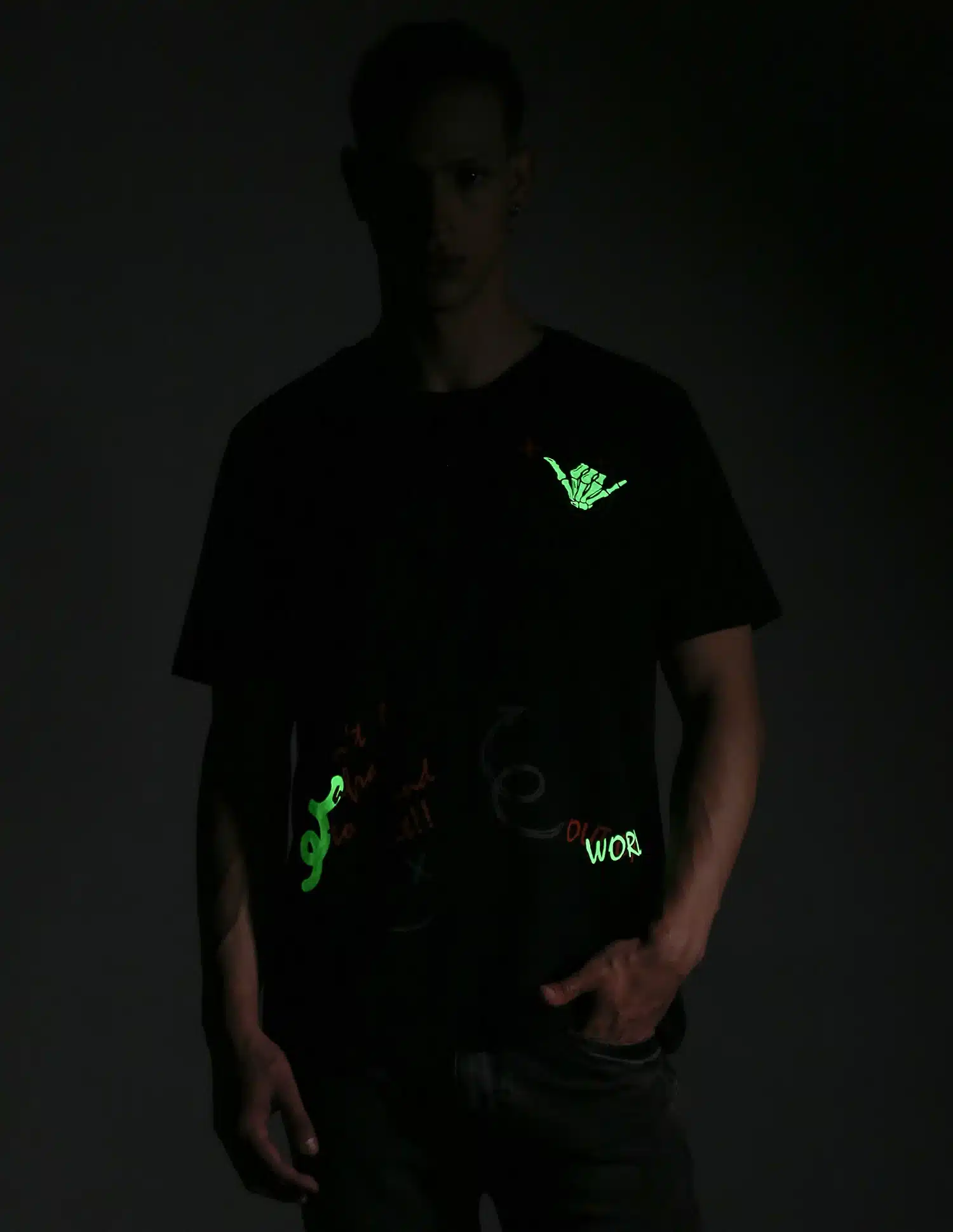
How It Works
Glow-in-dark printing uses special phosphorescent inks that absorb light and then emit a soft glow in the dark. The process typically involves screen printing technology to apply the glow-in-dark ink onto fabric. These techniques not only enhance the visual appeal of your clothing but also add a unique, practical touch. Imagine a t-shirt that glows under blacklight or a hoodie that lights up during a nighttime walk - it’s both stylish and functional!
Pro Tip: To get the brightest glow, expose your garment to direct light for at least 15-30 minutes before heading into the dark.
Advantages
Glow-in-dark printing offers plenty of benefits that make it a standout choice for custom logo printing:
Eye-Catching Appeal: Designs with glow-in-dark ink grab attention, especially in low-light settings. They’re perfect for making a bold statement.
Practicality: Glow-in-dark prints aren’t just for fun—they’re also functional. For example, they enhance visibility on safety gear like running or biking apparel, making them ideal for nighttime activities.
Unique Applications: Beyond clothing, glow-in-dark printing is used for items like blankets that emit a soothing glow, helping kids feel safe at night.
Did You Know? Glow-in-dark printing is a popular choice for event merchandise, especially for concerts or festivals. It adds a cool, interactive element to your designs.
Disadvantages
While glow-in-dark printing is undeniably cool, it does come with a few drawbacks:
Limited Glow Duration: The glow effect is brightest right after charging and gradually fades over time. You’ll need to recharge it under light for consistent results.
Fabric Limitations: This method works best on synthetic fabrics like polyester. Natural fibers like cotton may not hold the glow effect as effectively.
Higher Costs: The specialized inks and printing techniques can make this method pricier than traditional options.
Maintenance Needs: Proper care is essential to maintain the glow effect. Avoid harsh detergents or high-heat drying, as these can reduce the ink’s longevity.
Design Restrictions: Glow-in-dark printing works best with bold, simple designs. Intricate details may not glow as vividly, which could limit your creative options.
Despite these challenges, glow-in-dark printing remains a fantastic choice for creating unique, attention-grabbing designs.
Best Use Cases
Let’s explore where glow-in-dark printing truly shines:
Event Merchandise
Planning a concert, festival, or nighttime marathon? Glow-in-dark printing adds a unique twist to your event merchandise. T-shirts, wristbands, or caps with glowing designs create an interactive experience for attendees. Imagine your logo lighting up in a crowd - it’s a surefire way to leave a lasting impression.Kids’ Clothing and Accessories
Kids love anything that glows! Adding glow-in-dark designs to pajamas, backpacks, or shoes makes them fun and practical. Parents will appreciate the added visibility during evening outings, while kids will enjoy the magical glow.Safety Gear
Glow-in-dark printing isn’t just for fun - it’s functional too. Use it on running vests, biking gear, or even dog collars to enhance visibility at night. This method ensures safety without compromising style.Halloween Costumes and Party Wear
Glow-in-dark printing is perfect for spooky season! Create costumes that light up the night or party outfits that stand out under blacklight. From glowing skeleton designs to eerie patterns, this method takes Halloween to the next level.Sports and Activewear
Designing for athletes or fitness enthusiasts? Glow-in-dark prints on leggings, hoodies, or gym bags add a stylish and practical touch. They’re especially useful for early morning joggers or nighttime cyclists who need to stay visible.Promotional Products
Want your brand to stand out? Glow-in-dark printing works wonders on promotional items like tote bags, mugs, or keychains. These glowing giveaways grab attention and keep your brand memorable long after the event ends.
Pro Tip: Pair glow-in-dark designs with bold, simple shapes for maximum impact. Intricate details may not glow as brightly, so keep it clean and eye-catching.
Themed Apparel for Clubs or Groups
Whether it’s a dance crew, a gaming team, or a school club, glow-in-dark printing adds a fun, cohesive element to group outfits. Matching t-shirts or hoodies with glowing logos or slogans create a sense of unity and style.
Glow-in-dark printing is versatile, fun, and practical. Whether you’re creating event merchandise, safety gear, or just something unique, this method ensures your designs stand out - day or night.
8. Discharge Printing
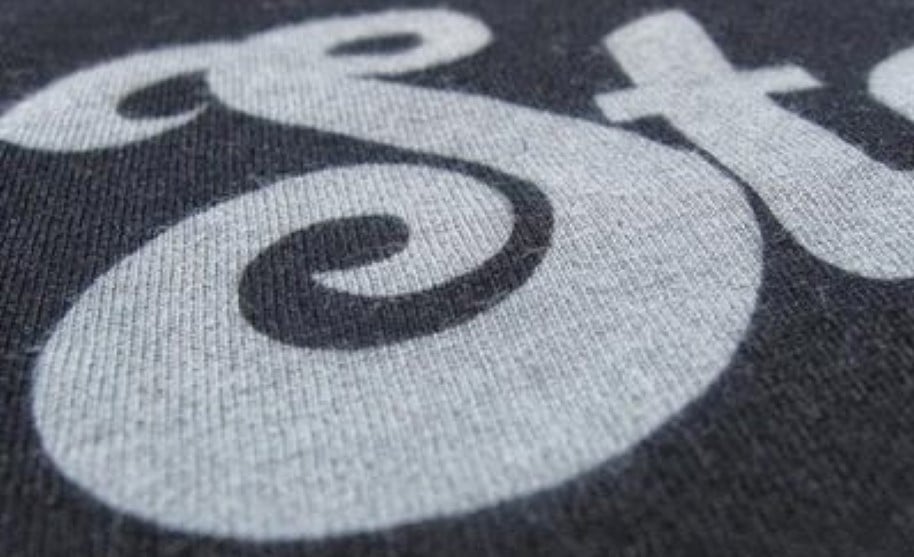
How It Works
Discharge printing is a fascinating method that works by removing the dye from dark fabrics to reveal lighter designs. Instead of layering ink on top of the fabric, this technique uses a discharge agent to bleach out the original color in specific areas. Once the dye is removed, you can leave the design as-is or add pigments to create vibrant colors.
Here’s how it happens: First, the fabric is prepped with a discharge ink that contains a bleaching agent. Then, heat is applied to activate the ink and remove the dye. Then, a soft, lightweight design that feels like part of the fabric itself. This method works best on pure cotton or natural fiber blends, as synthetic fabrics don’t respond well to the discharge process.
Pro Tip: Always test your fabric before starting. Not all dyes discharge evenly, so it’s important to check how your material reacts.
Advantages
Discharge printing offers several benefits that make it a standout choice for custom logo printing:
Produces vibrant colors on dark fabrics without the heavy feel of traditional inks.
Creates a soft-hand feel since the ink integrates with the fabric instead of sitting on top.
Maintains fine details in intricate designs, making it ideal for logos with small elements.
Offers superior durability, as the design becomes part of the fabric and resists cracking or peeling.
If you’re looking for a method that combines comfort and durability, discharge printing is a fantastic option. It’s especially great for creating high-quality designs on dark garments.
Disadvantages
Here are a few things to keep in mind:
Fabric Limitations: This method works best on 100% cotton. Blends with synthetic fibers or certain dyes may not discharge evenly, leading to inconsistent results.
Color Restrictions: The process is most effective on dark fabrics. Light-colored garments don’t benefit as much from this technique.
Chemical Sensitivity: Although discharge inks are water-based, they still contain bleaching agents. Proper ventilation and safety precautions are essential during the process.
Higher Costs: The specialized inks and additional steps can make discharge printing more expensive than simpler methods like screen printing.
Despite these challenges, discharge printing remains a top choice for creating soft, detailed designs on dark fabrics. If you’re aiming for a premium look and feel, this method delivers impressive results.
Best Use Cases
Discharge printing is a fantastic choice when you want soft, vibrant designs on dark fabrics. But where does it really shine? Let’s explore some of the best scenarios where this method works like magic.
High-End Fashion Lines
If you’re designing for a premium clothing brand, discharge printing can elevate your products. The soft, lightweight feel of the designs adds a touch of luxury. Customers love garments that look great and feel even better. Think trendy graphic tees, boutique hoodies, or stylish sweatshirts that stand out in a crowd.Band Merchandise
Got a band or planning a concert? Discharge printing is perfect for creating bold, detailed designs on dark t-shirts. Fans will appreciate the vibrant colors and the soft feel of the fabric. Plus, the durability ensures your merch looks great even after countless washes.Streetwear and Urban Apparel
Streetwear thrives on bold, eye-catching designs. Discharge printing lets you create intricate patterns or logos that pop on dark fabrics. Whether it’s oversized hoodies, joggers, or caps, this method gives your brand that edgy, urban vibe.Eco-Friendly Clothing Lines
If sustainability is your focus, discharge printing aligns perfectly. It uses water-based inks that are free from harmful chemicals. Pair this method with organic cotton fabrics to create eco-conscious apparel that appeals to environmentally aware customers.
Pro Tip: Stick to 100% cotton fabrics for the best results. Blends with synthetic fibers may not discharge evenly, which could affect the final look.
Did You Know? Discharge printing works best on dark fabrics like black, navy, or charcoal. It’s a great way to make your designs pop without adding extra layers of ink.
Discharge printing is a versatile method that combines style, comfort, and durability. Whether you’re creating fashion pieces, event merch, or branded apparel, this technique ensures your designs leave a lasting impression.
Choosing the right method to print a logo on fabric can feel overwhelming, but it doesn’t have to be. From screen printing for bulk orders to heat transfer for small batches, each method has its strengths. Direct-to-garment printing excels at intricate designs, while dye sublimation offers vibrant, long-lasting colors for polyester fabrics.
To make the best choice, consider your budget, design complexity, and durability needs. For affordable custom logo printing, methods like screen printing and heat transfer work well, especially when paired with bulk order discounts. If you’re unsure, ordering samples first ensures you’re happy with the quality custom logo printing before committing to a larger order.
Ultimately, balancing affordability and quality is key. Whether you’re creating print logo clothing for a business, event, or personal project, the right method ensures your designs stand out and last.
FAQ
1. What’s the best method for printing logos on cotton fabrics?
Screen printing works great for cotton. It’s durable, vibrant, and cost-effective for bulk orders. If you need detailed designs, direct-to-garment (DTG) printing is another excellent option.
2. Can I print logos on stretchy fabrics like spandex?
Yes, heat transfer printing is ideal for stretchy fabrics. It adheres well and maintains flexibility. Dye sublimation also works if the fabric has a polyester blend.
3. Which method is the most eco-friendly?
DTG and discharge printing are eco-friendly options. Both use water-based inks and produce minimal waste. Pair them with organic fabrics for sustainable results.
4. How do I choose the right method for small orders?
For small batches, go with screen printing, heat transfer or DTG printing. Both have low setup costs and allow you to print one item at a time without breaking the bank.
5. Can I print multi-color designs without spending too much?
Heat transfer printing is perfect for multi-color designs. It doesn’t require separate setups for each color, making it affordable and efficient for complex artwork.
6. What’s the most durable method for logos on workwear?
Embroidery is the most durable option. It withstands heavy use and frequent washing, making it ideal for uniforms and workwear.
7. Are glow-in-dark prints safe for kids’ clothing?
Absolutely! Non-toxic phosphorescent inks are available for the glow-in-dark printing. They’re safe for kids and add a fun, practical touch to their clothing.
8. Can I print logos on dark fabrics without heavy ink layers?
Discharge printing is your best bet. It removes the dye from dark fabrics, leaving a soft, lightweight design that feels like part of the material.





